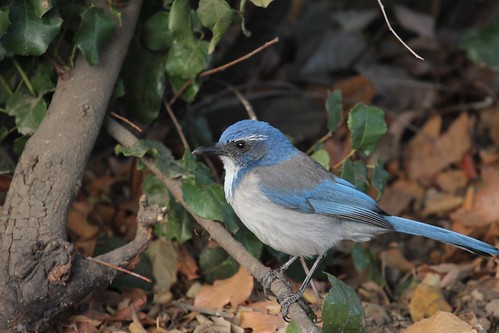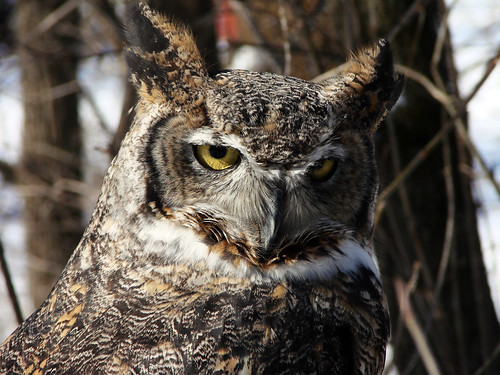Back in 2012, a paper in the journal Animal Behavior presented a study about Western Scrub-Jays titled “Western scrub-jay funerals:
cacophonous aggregations in response to dead conspecifics.” Researchers placed several
objects, including pieces of wood, stuffed scrub jays, stuffed Great Horned
Owls, and dead scrub jay carcasses, into people’s backyards to observe how the neighborhood
scrub jays responded. Jays are naturally curious, and they discovered and
inspected all the objects, though spent very little time checking out the wood.
Dead scrub jays that had been stuffed and mounted in life-like poses elicited
aggression. I’ve often noticed that sociable birds seem more distressed and
aggressive toward a bird of their own species when that bird looks or acts
different from the others. When I rehabbed, I could never let an injured crow
out in my yard, because neighborhood crows would attack it. Intriguingly, many
published observations as well as my own find that when a crow is injured or
has a physical deformity, its family and neighborhood flock mates do not attack
it, but often actually provide help, bringing it food and protecting it from
nearby predators. But the combination of being a stranger and acting odd
elicits aggression in crows, much as many of our own species have trouble dealing
with people who look or act different from them. Something that looks like a
perfectly normal jay but doesn’t move or react to others would seem pretty odd to
jays who have never experienced such a thing before.
A stuffed and mounted Great Horned Owl elicited “hundreds of
long-range communication vocalizations.” Squawking to beat the band calls in squads
of other scrub jays, as the birds alert one another to the danger and work
together to drive the predator away. Intriguingly, the researchers found that a prostrate dead jay also got a similar response, both in the high number of calls and in drawing
in other scrub jays from afar. I noticed something similar with Blue Jays, back
in the days when I was an occasional counter at Hawk Ridge. If a hawk nailed a
Blue Jay out of a flock of migrants, the whole group remained in the area,
often for 45 minutes or longer, yelling their heads off in what I called an
Irish wake.
Both the mounted owl and the dead scrub jay caused the other
scrub jays to decrease their foraging for food in the area for over 24 hours.
The authors concluded in their abstract, “Our results show that without
witnessing the struggle and manner of death, the sight of a dead conspecific is
used as public information and that this information is actively shared with
conspecifics and used to reduce exposure to risk.”
For some reason, a story about that research paper went
around on Facebook last week as if it were new information, and several birders
quickly started criticizing the authors’ use of the word “funeral.” That and my
own use of “Irish wake” naturally smack of anthropomorphism.
We humans can’t
help but compare animal behaviors to our own. It is completely unscientific to
draw a conclusion that animals grieve the loss of individuals or recognize death
in the same way we humans do, but it’s equally unscientific to state that they
don’t. In the study, those Western Scrub-Jays were hardly grieving the loss of
one of their own—the authors didn’t kill a local jay for their dead specimen,
so of course the jay wasn’t recognized as a particular individual, and the
jays’ reactions almost certainly couldn't be called grief. But the ways we humans
announce and gather after the deaths of our own conspecifics suggest that our
funerals may serve the same purpose as the gatherings of those scrub-jays. We
can’t yell as loud as they, but we ring the alarm far and wide in the obituary
pages of our newspapers and on the news. Our own funerals involve family and
close friends grieving for the loss of someone they love, but also include the
wider community, many who are not grieving at all. If you listen in on
conversations at any wake or funeral, you’ll hear people, including genuinely grieving
loved ones, talking about the cause of death in ways that suggest we’re all
using that information in hopes of forestalling our own deaths, just as the
scrub-jays of the study apparently did. Some people pooh-pooh the idea that animals are
capable of understanding death or envisioning their own. But we have plenty of
evidence that a lot of humans, and not just reckless teenagers, can’t envision
our own mortality or wrap our own heads around the concept of death, either.
Lots of data affirm that some species of birds and
mammals suffer physiological stress after the death of a mate or young similar
to the physiological stress of grieving humans. It’s fun to think we’re
superior to animals and capable of deeper love than they, but considering the
high murder and divorce rates between family members in our own species, that
superiority is pretty questionable. Every species reacts to different things in
different ways—including us—but we share a lot of common ground. Dismissing the
term “funeral” for the scrub jays in this study seems to deny that truth. If we
ever came upon intelligent life forms in outer space, there is no way we could hope
to communicate with them until we figure out how to better understand and
communicate with the intelligent life forms right here on earth.


